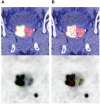Reliability of gradient-based segmentation for measuring metabolic parameters influenced by uptake time on 18F-PSMA-1007 PET/CT for prostate cancer
- PMID: 36249043
- PMCID: PMC9559596
- DOI: 10.3389/fonc.2022.897700
Reliability of gradient-based segmentation for measuring metabolic parameters influenced by uptake time on 18F-PSMA-1007 PET/CT for prostate cancer
Abstract
Purpose: To determine an optimal setting for functional contouring and quantification of prostate cancer lesions with minimal variation by evaluating metabolic parameters on 18F-PSMA-1007 PET/CT measured by threshold-based and gradient-based methods under the influence of varying uptake time.
Methods and materials: Dual time point PET/CT was chosen to mimic varying uptake time in clinical setting. Positive lesions of patients who presented with newly diagnosed disease or biochemical recurrence after total prostatectomy were reviewed retrospectively. Gradient-based and threshold-based tools at 40%, 50% and 60% of lesion SUVmax (MIM 6.9) were used to create contours on PET. Contouring was considered completed if the target lesion, with its hottest voxel, was delineated from background tissues and nearby lesions under criteria specific to their operations. The changes in functional tumour volume (FTV) and metabolic tumour burden (MTB, defined as the product of SUVmean and FTV) were analysed. Lesion uptake patterns (increase/decrease/stable) were determined by the percentage change in tumour SUVmax at ±10% limit.
Results: A total of 275 lesions (135 intra-prostatic lesions, 65 lymph nodes, 45 bone lesions and 30 soft tissue lesions in pelvic region) in 68 patients were included. Mean uptake time of early and delayed imaging were 94 and 144 minutes respectively. Threshold-based method using 40% to 60% delineated only 85 (31%), 110 (40%) and 137 (50%) of lesions which all were contoured by gradient-based method. Although the overall percentage change using threshold at 50% was the smallest among other threshold levels in FTV measurement, it was still larger than gradient-based method (median: 50%=-7.6% vs gradient=0%). The overall percentage increase in MTB of gradient-based method (median: 6.3%) was compatible with the increase in tumour SUVmax. Only a small proportion of intra-prostatic lesions (<2%), LN (<4%), bone lesions (0%) and soft tissue lesions (<4%) demonstrated decrease uptake patterns.
Conclusions: With a high completion rate, gradient-based method is reliable for prostate cancer lesion contouring on 18F-PSMA-1007 PET/CT. Under the influence of varying uptake time, it has smaller variation than threshold-based method for measuring volumetric parameters. Therefore, gradient-based method is recommended for tumour delineation and quantification on 18F-PSMA-1007 PET/CT.
Keywords: PET; PSMA; metabolic tumour burden; prostate cancer; tumour; tumour delineation; tumour volume; uptake time.
Copyright © 2022 Lau, Chen, Ho and Cai.
Conflict of interest statement
The authors declare that the research was conducted in the absence of any commercial or financial relationships that could be construed as a potential conflict of interest.
Figures


Similar articles
-
More advantages in detecting bone and soft tissue metastases from prostate cancer using 18F-PSMA PET/CT.Hell J Nucl Med. 2019 Jan-Apr;22(1):6-9. doi: 10.1967/s002449910952. Epub 2019 Mar 7. Hell J Nucl Med. 2019. PMID: 30843003
-
Optimization of PET reconstruction algorithm, SUV thresholding algorithm and PET acquisition time in clinical 11C-acetate PET/CT.PLoS One. 2018 Dec 13;13(12):e0209169. doi: 10.1371/journal.pone.0209169. eCollection 2018. PLoS One. 2018. PMID: 30543705 Free PMC article.
-
Intra-Individual Comparison of 18F-PSMA-1007 and 18F-FDG PET/CT in the Evaluation of Patients With Prostate Cancer.Front Oncol. 2021 Feb 1;10:585213. doi: 10.3389/fonc.2020.585213. eCollection 2020. Front Oncol. 2021. PMID: 33604285 Free PMC article.
-
68Ga-PSMA-11 PET/CT derived quantitative volumetric tumor parameters for classification and evaluation of therapeutic response of bone metastases in prostate cancer patients.Ann Nucl Med. 2019 Oct;33(10):766-775. doi: 10.1007/s12149-019-01387-0. Epub 2019 Jul 23. Ann Nucl Med. 2019. PMID: 31338731
-
68Ga-PSMA-11 PET/CT in primary staging of prostate cancer: PSA and Gleason score predict the intensity of tracer accumulation in the primary tumour.Eur J Nucl Med Mol Imaging. 2017 Jun;44(6):941-949. doi: 10.1007/s00259-017-3631-6. Epub 2017 Jan 31. Eur J Nucl Med Mol Imaging. 2017. PMID: 28138747
Cited by
-
Furosemide Reduces Radionuclide Activity in the Bladder in 18F-PSMA-1007-PET/CT: A Single-Center Retrospective Intra-Individual Comparative Study.Diagnostics (Basel). 2025 Jul 31;15(15):1931. doi: 10.3390/diagnostics15151931. Diagnostics (Basel). 2025. PMID: 40804895 Free PMC article.
-
PET/CT imaging 2 h after injection of [18F]PSMA-1007 can lead to higher staging of prostate cancer than imaging after 1 h.Eur J Hybrid Imaging. 2023 May 1;7(1):9. doi: 10.1186/s41824-023-00167-4. Eur J Hybrid Imaging. 2023. PMID: 37121920 Free PMC article.
-
Radiomics and Artificial Intelligence in Radiotheranostics: A Review of Applications for Radioligands Targeting Somatostatin Receptors and Prostate-Specific Membrane Antigens.Diagnostics (Basel). 2024 Jan 14;14(2):181. doi: 10.3390/diagnostics14020181. Diagnostics (Basel). 2024. PMID: 38248059 Free PMC article. Review.
-
ESTRO ACROP consensus recommendation on the target volume definition for radiation therapy of macroscopic prostate cancer recurrences after radical prostatectomy.Clin Transl Radiat Oncol. 2023 Sep 23;43:100684. doi: 10.1016/j.ctro.2023.100684. eCollection 2023 Nov. Clin Transl Radiat Oncol. 2023. PMID: 37808453 Free PMC article. Review.
References
-
- Bettermann AS, Zamboglou C, Kiefer S, Jilg CA, Spohn S, Kranz-Rudolph J, et al. . [(68)Ga-]Psma-11 Pet/Ct and multiparametric mri for gross tumor volume delineation in a slice by slice analysis with whole mount histopathology as a reference standard - implications for focal radiotherapy planning in primary prostate cancer. Radiother Oncol (2019) 141:214–9. doi: 10.1016/j.radonc.2019.07.005 - DOI - PubMed
-
- Walacides D, Meier A, Knöchelmann AC, Meinecke D, Derlin T, Bengel FM, et al. . Comparison of 68ga-psma ligand Pet/Ct versus conventional cross-sectional imaging for target volume delineation for metastasis-directed radiotherapy for metachronous lymph node metastases from prostate cancer. Strahlenther Onkol (2019) 195(5):420–9. doi: 10.1007/s00066-018-1417-9 - DOI - PubMed
-
- Syndikus I, Cruickshank C, Staffurth J, Tree A, Henry A, Naismith O, et al. . Pivotalboost: A phase iii randomised controlled trial of prostate and pelvis versus prostate alone radiotherapy with or without prostate boost (Cruk/16/018). Clin Transl Radiat Oncol (2020) 25:22–8. doi: 10.1016/j.ctro.2020.08.003 - DOI - PMC - PubMed
LinkOut - more resources
Full Text Sources
Miscellaneous

